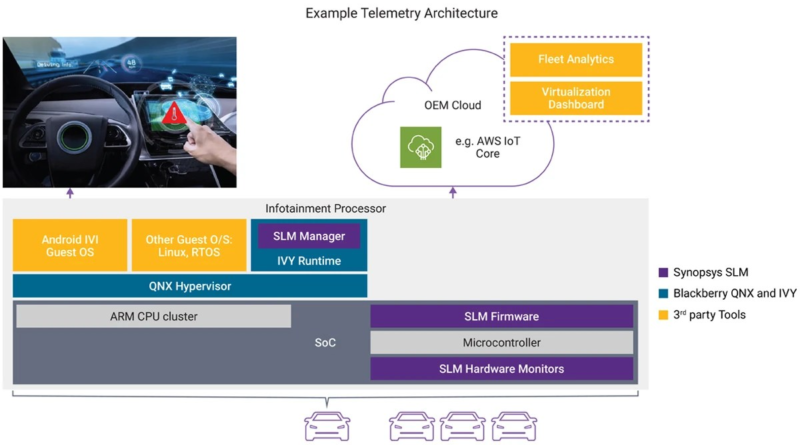Kết hợp thu thập dữ liệu silicon và xử lý cạnh mang lại giải pháp đầy hứa hẹn cho các OEM ô tô
By Lorin Kennedy and Jasmin Mulaosmanovic
In the world of electric (EV) and software-defined vehicles (SDV), a key challenge and opportunity besets original equipment manufacturers (OEM): that of effectively harnessing in-vehicle and silicon data to improve user experience and quite literally drive business benefits. While collecting telemetry data is straightforward enough, the difficulty lies in achieving the contextual understanding to transform it into valuable insights.
For example, OEMs generally understand the negative impact of extreme temperatures on vehicle electronics, but not at a holistic level. In addition to temperature, silicon variables such as timing margins, voltage, and electromigration due to activity along with physical and environmental factors such as driving speed, driver assist features, external temperature, state of charge, and usage of in-vehicle infotainment all play a role in the life expectancy of an automotive chip.
Consider the Arizona heatwave of July 2023, where the average temperature approached 103°F. Synopsys modeling indicated that within a 45-day window under such conditions, silicon could lose up to 10% of its useful life. This carries significant implications given the potential for multiple bouts of extreme heat in certain regions. Monitoring silicon temperature in the context of a given environment is a way to track the stress that can lead to unexpected system failures. In the above case, while ambient temperature can lead to damage, silicon junction temperature can be 2x based on the chip activity or the structural cooling design of the system. Thus, observation and early diagnosis is crucial to avert the breakdown of electronic automotive components such as advanced driver assistance systems (ADAS) and uphold safety as well as wider functionality.
Taking this scenario a step further, let’s imagine an EV owner is charging their car at a station in sweltering heat. They are watching a documentary while their child is in the back seat playing a video game on the rear seat infotainment unit while the air conditioning is blasting. Suddenly, a message flashes: “Your vehicle infotainment unit is overheating. Please reduce usage to cool it down.” After this warning message, additional details appear on the screen for the vehicle owner to educate themselves that reducing gaming or video playback will help cool down the infotainment unit and extend the life of their vehicle semiconductor components along with how to prevent future occurrences. The message is based on data collected from the vehicle and analyzed in real time.
Using anonymized diagnostic telemetry data from tens of thousands of cars, it becomes possible to offer proactive, specific guidance to owners based on their current usage of the vehicle, suggest preventative maintenance that might need to be done to their specific car, and provide regional warnings based on weather forecasts to help prevent silicon damage and extend their vehicle’s lifetime.
As of today, there is no single company that can provide the support, insights, and technology necessary for such a solution, but BlackBerry QNX and Synopsys are looking to team up to change that. BlackBerry IVY is an in-vehicle data platform that incorporates edge processing and plans to enable a more proactive future for software-defined vehicles—one that can incorporate the advanced silicon health monitoring prognostics provided by Synopsys.
Continuous improvement through edge analytics
Let’s first examine the BlackBerry IVY platform, which enables automakers and their partners to innovate more effectively. Co-developed with Amazon Web Services (AWS), BlackBerry IVY software abstracts vehicle signals, enabling processing at the edge and cloud-controlled access to vehicle data. Car makers and software developers benefit from quicker development times, data connectivity savings, and optimized data processing using in-vehicle machine learning (ML).
The flow of the BlackBerry IVY Platform is as follows:
- Data is collected from an SDV’s various sensors and systems including vehicle diagnostics, ADAS, body, cabin, and cameras.
- This data is processed in real-time using edge computing capabilities within the vehicle. This includes data filtering, normalization, and aggregation.
- Machine learning algorithms and analytics extract insights from the data related to vehicle performance and health, driver recognition and monitoring, and environmental conditions.
- These IVY insights enable OEMs to rapidly experiment, innovate, and deploy new features over the lifecycle of the SDV in the areas of vehicle lifecycle and operations (e.g., predictive maintenance and insurance), e-commerce and monetization (e.g., in-vehicle payment), in-cabin experiences (e.g., personalization), and safety and security (e.g., crash analytics and driver authentication).
While BlackBerry IVY’s strengths lie in its processing of data within the vehicle, its connectivity to the cloud further boosts SDV value as it can share data and insights to the cloud as well as receive new logic and configurations. Additionally, it can input data from the cloud to enhance in-vehicle algorithms.
Comprehensive data capture for big picture understanding
In parallel, Synopsys has its own unique capabilities for predictive maintenance and silicon health monitoring. Synopsys’ Silicon Lifecycle Management (SLM) suite includes software to observe and analyze the environmental, structural, and functional monitors that are embedded during the manufacturing process to gather data from the operation of the vehicles’ chips in-field.
Synopsys offers AI-based analytics tools capable of processing petabytes of data on-chip so that only actionable insights are shared with the application operating system. Depending on the use case, notifications or alerts can be sent to the application, the driver, or off-board for further analysis and remediation.
Insights through combined excellence
Fig. 1: While hardware systems and architecture vary, real-time SLM silicon health data can be shared with an analytics engine like IVY for contextual insights for display within the vehicle or for cloud analytics.
When combining Synopsys’ SLM solutions with BlackBerry IVY, OEMs gain the ability to correlate key silicon data such as temperature, voltage, timing margins, and stress information with other vehicle diagnostic data such as cabin and exterior temperatures and usage patterns causing high software workloads for the central processing unit (CPU) and memory.
With this new level of insights, OEMs can expand their predictive maintenance capabilities, reduce warranty claims, and inform the design and testing process, supporting improvements in each generation of system-level components. In addition to helping to extend silicon longevity and the lifetime of the vehicle overall, greater diagnostic insights offer new potential revenue streams for OEMs in the form of better warranty protection and predictable coverage packages.
OEMs can benefit from:
- Customer Value: Drivers receive proactive system notifications concerning environmental behaviors that can reduce the longevity and/or safety of electronic components.
- Predictive Maintenance: Anomalous activity can help OEMs understand environmental or design factors influencing SoC aging and stress, tracing fleet vehicles encountering similar issues and making maintenance more targeted to reduce recalls.
- Expense reduction: ‘Fail-over’ systems are currently a prerequisite for ASIL-D certification for certain critical safety elements. However, in the new ISO 26262 standard, silicon health monitoring is proposed as a means to help achieve the highest ASIL rating.
- Brand loyalty: Offers the ability to analyze compute ‘headroom’ to introduce advanced subscription-based features or product enhancements over the lifetime of the vehicle.
- Data privacy: BlackBerry IVY software sensors enable in-vehicle business logic deployment to process insights, reducing vehicle-to-cloud data transmission costs which helps the OEM comply with regulations and respect driver and passenger privacy.
A future of prolonged vehicle life
Ultimately, effective silicon health monitoring combined with other advanced vehicle diagnostics can prolong the useful lifetime of a vehicle. Owners now expect to run their vehicles for longer periods, with the average recently extended from 10 to 12 years.
As SDVs move to more advanced architectures and high-performance compute (HPC) nodes with longer periods of operation, a holistic understanding of silicon performance in the automotive field is becoming vital. Effective monitoring today sets the foundation for greater efficiency in the future. Together with BlackBerry IVY, Synopsys can bring silicon-level data that will enable detailed behavior modeling over time, covering all aspects of SLM — a compelling proposition for a business sector defined by complexity and variability as much as by innovation.
Jasmin Mulaosmanovic is a product management director at BlackBerry QNX.


